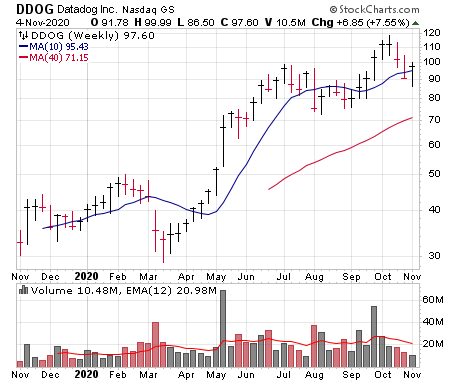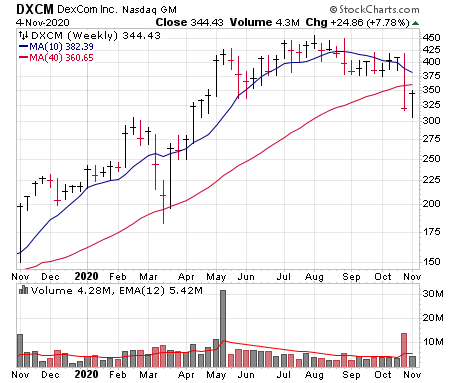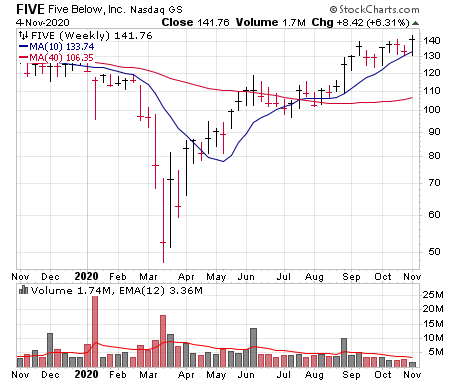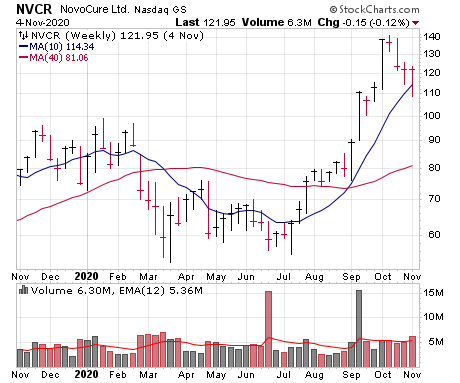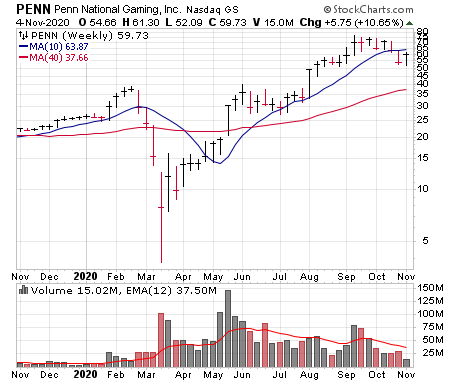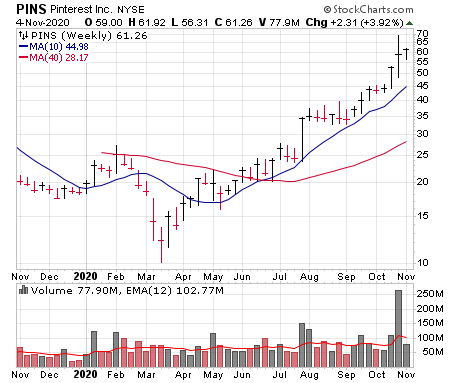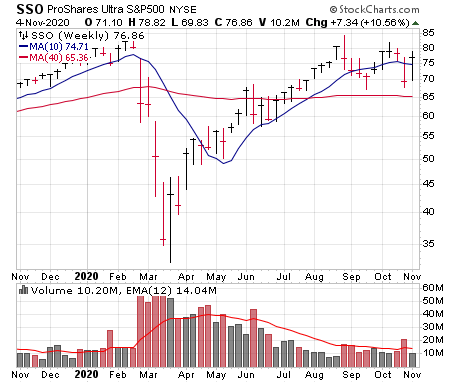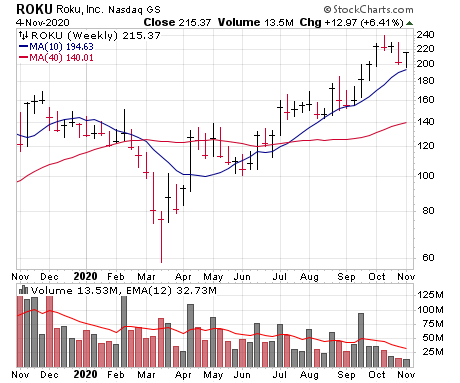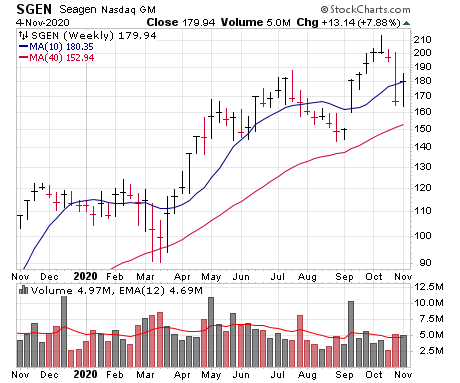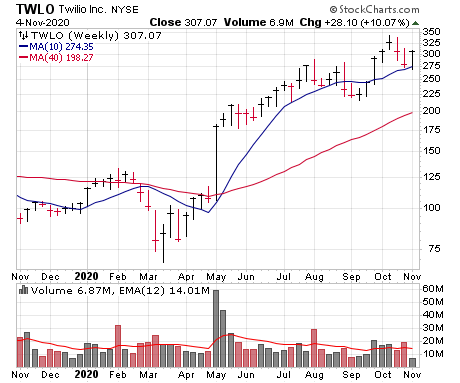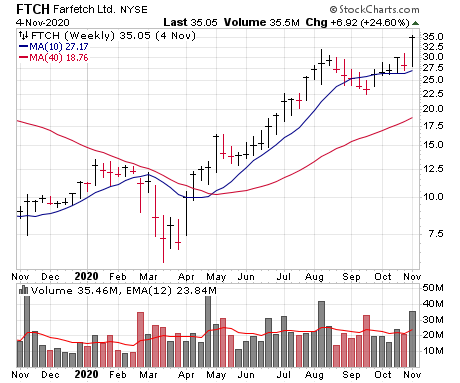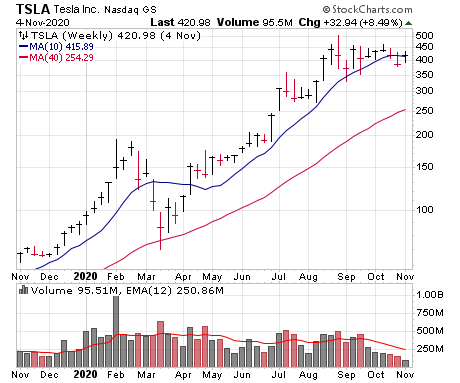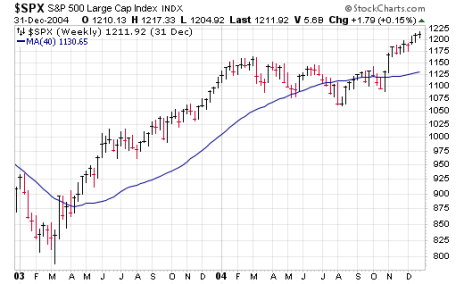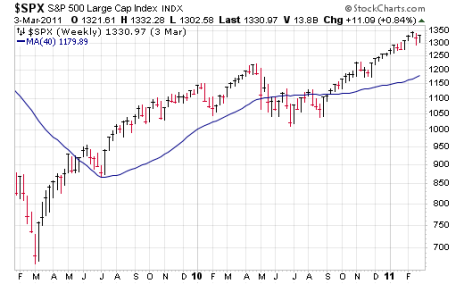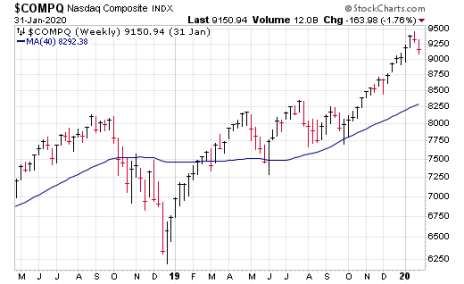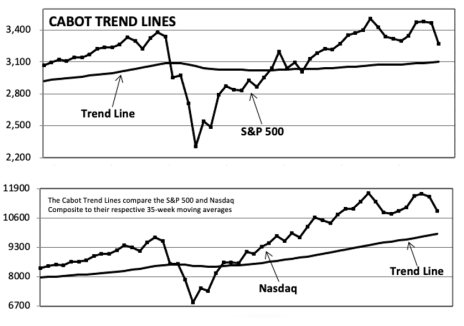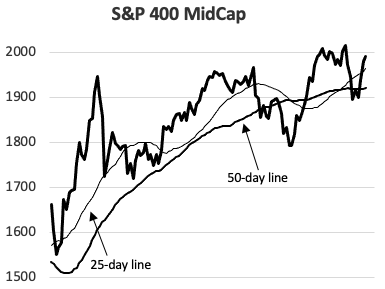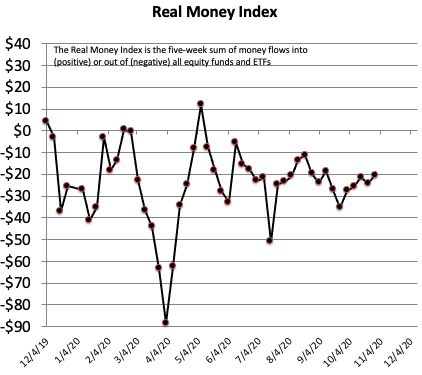The market’s recovery this week has been very impressive, especially in the face of what looks like continued election uncertainty in the days ahead. That said, two days of action isn’t the be-all, end-all, but it’s certainly encouraging; we’re adding one new half position tonight in Novocure (NVCR) and aiming to add more. The only issue is that many stocks we’re high on are reporting earnings tonight or early next week; if they can survive their reports, we’ll likely be putting money to work.
In tonight’s issue, we write about all our stocks and some bullish signposts for the market longer-term--whether we’re seeing a kickoff here or whether it takes a while longer, the odds strongly favor the past two months being a normal rest within a major bull market.
Cabot Growth Investor 1458
[premium_html_toc post_id="219182"]
Believe What You See
There are usually a couple of times each year where the market really messes with people, catching the vast majority of investors off-guard. (Remember the old saw: The market does what it has to do to fool the most investors possible.) One of those times certainly came after the bottom in March, when stocks embarked on a stunning advance despite the horrid economic (and real-world) conditions that had investors wondering when the bottom would fall out for three or four months after the major low. That’s why it’s important to believe what you see and not invest based on beliefs.
Now we might be getting the second “this makes no sense!” market move of 2020. As we write, it looks like the market’s fears has come true, as two days after the election, vote counting is still going on, lawsuits have been filed and, even down ballot, control of the Senate may come down to a couple of runoff elections in the months ahead. In other words, there’s still plenty of uncertainty, which was supposedly the reason stocks slid sharply last month.
But instead of selling off, the market has spiked! And the buying isn’t in safe mega-caps or stodgy consumer staples stocks; rather, many of this year’s leading growth titles, which were hit hard last month, have come roaring back. Indeed, the Nasdaq has popped all the way back to its October highs, which has helped Cabot’s Aggression Index, which we wrote about in the last issue, near its highs for the year.
Of course, two days doesn’t make a trend—many stocks, while surging this week, are basically back to where they were in October (and for many, back in September too). It’s a similar story for the indexes, with many near the top end of the ranges they’ve occupied for the past two-plus months; our Cabot Tides remain effectively neutral because of this. So, at least to this point, this isn’t some blastoff of epic proportions.
But our evaluation involves the bigger picture, not just the past couple of trading days. Stepping back, the market needed a consolidation after the huge March-August upmove, and the two sharp corrections since Labor Day (10%-plus in September, and the recent straight-down 8% drop) may have been enough to scare out the weak hands. It’s not a done deal but the early returns are encouraging. Indeed, historically speaking, four straight big up days (like we’ve seen from the S&P 500) usually occurs near major lows, not peaks.
When it comes to individual stocks to buy, the situation gets a bit trickier—mainly because a handful of our favorite names are literally reporting earnings tonight! Thus, we’re adding just one half-sized position in tonight’s issue, but if the market continues to flex its muscles and some fresh leaders get through earnings, we’re game for extending our line in the days ahead.
What To Do Now
Hold your strong performers and be selective on new buys as we see if this pop is the Real McCoy. In the Model Portfolio, we cut loose our weakest performers during the October slide, but tonight, we’ll add a half-sized position in NovoCure (NVCR), bringing our cash position down to around 41%, while aiming for some new buys in the days ahead depending on the evidence.
Model Portfolio Update
This week’s action has been very encouraging, though it goes along with the vicious ups and downs we’ve seen since early September. In the Model Portfolio, we’ve been bobbing and weaving with the market, and that’s meant paring back during the past couple of weeks as growth stocks got hit. Given that we have north of 40% in cash (and are still handily up for the year overall), we’re putting a little money back to work tonight (half position in NVCR), and the goal is to add some more new names in the near future--but a lot will depend on how the market and (maybe more importantly) reactions to various earnings reports in the days ahead.
Current Recommendations
| Stock | No. of Shares | Portfolio Weightings | Price Bought | Date Bought | Price on 11/5/20 | Profit | Rating |
| Datadog (DDOG) | 1,667 | 8% | 110 | 10/9/20 | 102 | -7% | Hold |
| Dexcom (DXCM) | — | — | — | — | — | — | Sold |
| Five Below (FIVE) | 1277 | 10% | 138 | 9/18/20 | 142 | 3% | Buy |
| Novocure (NVCR) | New | — | — | — | 122 | — | Buy a Half |
| Penn Gaming (PENN) | — | — | — | — | — | — | Sold |
| Pinterest (PINS) | 4444 | 15% | 40 | 9/18/20 | 63 | 59% | Buy |
| ProShares Ultra S&P 500 (SSO) | 1,741 | 7% | 60 | 5/29/20 | 80 | 33% | Buy |
| Roku (ROKU) | 548 | 6% | 170 | 8/28/20 | 225 | 33% | Buy a Half |
| Seagen (SGEN) | — | — | — | — | — | — | Sold |
| Twilio (TWLO) | 553 | 9% | 174 | 5/8/20 | 308 | 77% | Buy |
| CASH | $824,619 | 46% |
Datadog (DDOG)—After cutting back on other names and building what became a large cash position, we decided to hold to our max loss limit (20% from our cost basis, which is right at 88 on a closing basis)—and the stock barely held above that before bouncing nicely with growth stocks the past couple of days. The question here is whether DDOG (along with many growth stocks that have had straight-down moves) are sold out in the intermediate-term; bigger picture, the stock really doesn’t look that bad, with the down, up, and down action looking a lot like a tedious consolidation following the big spring/summer run. If the stock can hold above our loss limit we’re OK giving it a chance, but the big key will probably be the quarterly report next Tuesday (November 10). Analysts see sales up 51% in Q3 and earnings of a penny per share, but as with everything, the reaction will be vital. Right here, we’re continuing to hold our shares, albeit with a tight leash. HOLD.
Dexcom (DXCM)—We gave DXCM every chance to get going, but after the Q3 report, it’s looking like the stock’s long-term uptrend has gone up in smoke—not only did growth decelerate to its slowest rate in a few quarters (sales up “only” 26%), but that compared to a pickup in growth seen from the competition (Abbott’s Libre CGM had some good results in the quarter). Plus, the delay of the firm’s next-generation G7 well into next year likely means competitive pressures will stay on investors’ minds for a while. Shares cracked badly on the news, and we took the rest of our profit off the table the day after the report; while it’s bounced a bit, we think there will definitely be better performers out there during the market’s next sustained uptrend. SOLD.
Five Below (FIVE)—FIVE has been acting calmly since mid-September, one of the few growth stocks you can say that about, and now it looks like it wants to get moving—shares have nosed out to recent (and multi-year) highs as the market enjoys a post-election rally. There’s still the potential for some shenanigans (China tariff policy is still a macro factor that could pop its head up), but our overall thoughts here haven’t changed: After two years of dealing with trade wars and the pandemic, Five Below has turned the corner, putting its reliable growth story (low single digit same-store sales growth, 15% to 20% annual store growth, best-in-class store economics and a very economically-resilient product line) back on track, which in turn should keep big investors interested. Earnings are likely out in about a month, so there’s time before worrying about that. All in all, we continue to see higher prices ahead. BUY.
NovoCure (NVCR)—We’ve been following NVCR off and on for a couple of years; shares lost their leadership status in the summer of last year and spent a year gyrating all over the place. However, the underlying story never changed—the company has a unique way to help treat certain cancers using what are known as tumor treating fields; in laymen’s terms, these are prolonged, low doses of radiation that mess with cancer cells ability to reproduce, eventually killing them. The system, dubbed Optune, is approved for a couple of niche cancers right now, but that’s been enough to keep growth cranking—sales are up between 34% and 44% each of the past four quarters, while earnings are lifting from breakeven. (And analysts see more of that going forward, with 25%-ish top-line growth and 80%-plus earnings growth in 2021.) But the real payoff could come from some trial results in 2021—Novocure is set to release five sets of results of Optune’s effectiveness (often alongside chemo or other treatments) treating various cancers, including three Phase III sets of results for lung, ovarian and certain lung cancer. If all goes well the company’s target market should expand many-fold within two or three years! Back to the stock, NVCR had a massive run from July through September that took it to new highs before a tough pullback with all growth stocks (and after a convertible share offering) during the past three weeks. It’s always possible the stock falls from here, but it’s found support at its 50-day line and has begun to bounce. We’ll start with a half position and look to buy more if the stock and market continue to lift. BUY A HALF.
Penn National Gaming (PENN)—Our timing with PENN was off from the get go, as growth stocks cratered afterwards and gaming stocks (including peer DraftKings) were taken apart. Fundamentally, everything looks on-track here: Penn National’s Q3 report topped expectations, with solid early results from its Barstool sports betting app in Pennsylvania (48,000 registered in the first month in PA alone, with 30,000 first-time depositors betting $78 million). We’ll keep an eye on the stock; this is a new theme, so if PENN can set up again, maybe we take another swing at it. But we cut bait last week and have some other, stronger situations on our watch list right now. SOLD.
Pinterest (PINS)—We’ve written many times that Pinterest has the story, numbers, and chart to be a powerful new leader, and that looks to be playing out after the firm’s blowout Q3 report. The headline numbers (sales up 58%, earnings of 13 cents per share up from a penny a year ago) and sub-metrics (user growth of 37%, continuing the prior quarter’s strong trends) were impressive, but just as encouraging was some of the commentary from the top brass: New users this year, for instance, have shown higher retention and engagement than prior new-user cohorts; video uploads were up seven-fold, boosting sticky content; and, sales-wise, new ad tools (automatic bidding for conversions launched in July and has been a huge hit) and more shopping-related links have helped. Looking ahead, Pinterest’s one-of-a-kind offering for both users and advertisers should produce tons of upside, especially as revenue-per-user (just $3.85 in U.S., which is low compared to other properties; Snap’s comparable figure is nearly $5.50) lifts as ad tools continue to improve. The stock soared after the news and, while there’s been a few wiggles since then, PINS remains in great shape—it may consolidate further, but we’d bet big investors will be building positions in what looks like one of the next hot online stories. BUY.
ProShares Ultra S&P 500 Fund (SSO)—It’s been a hectic past couple of months for SSO as the S&P 500 has chopped around. Ideally, the two good-sized corrections since Labor Day (10% in September, 8% last month) have scared out enough weak hands to pave the way for a meaningful advance, and the powerful rebound this week after testing the September low bodes well. Indeed, here’s an interesting nugget: Today was the fourth straight 1% up day in the S&P 500, which has only been seen three other times since 1970, and all led to huge (mid 20%) gains a year later. (Hat tip to Ryan Detrick of LPL Financial for the data.) We’re not putting all our eggs in such a limited study, but with the longer-term uptrend never in doubt and this week’s pop, we’ll restore our Buy rating. BUY.
Roku (ROKU)—ROKU got caught up in the growth stock selling late last week and then again on Tuesday, when news that Comcast and Walmart would team up on developing and selling smart TVs caused a brief wave of selling (we view that as superficial bad news, as Roku is the hands-down leader and this story is all about the firm’s platform, not hardware/TV sales). Even so, the stock held its 50-day line (the first test of that trend line since getting going, which usually brings out the buyers) and has bounced nicely, though earnings tonight will be critical—total revenues are expected to rise 40% with a loss of 40 cents per share, but far more important will be the sub-metrics (especially new user growth) and commentary about both customer engagement (has it continued to pick up as it did in the early stages of the pandemic?) and any hints about advertiser intentions (there have been more than a few rumbles about big firms reallocating ad dollars to over-the-top platforms like Roku’s). We remain optimistic, and a bullish reaction could have us filling out our position, but we’ll just take it as it comes. We’ll stick with our Buy a Half rating but will have any updates as need be. BUY A HALF.
Seagen (SGEN)—The market is an odds game, but that doesn’t mean some high-odds plays won’t bite the dust, and that’s exactly what happened with Seagen—all the factors were lined up, but the growth stock environment turned sour and, to be frank, the firm’s Q3 report was a bummer, with the company actually reducing sales guidance slightly, causing the stock to gap below its 50-day line. It has bounced in recent days, but it remains well off its peak and is likely going to need some repair work. SOLD.
Twilio (TWLO)—TWLO’s September breakout failed, but shares never did anything wrong (held their 50-day line and partially filled the Investor Day gap up from early October) and have now started to rebound along with most other growth stocks. If you’re looking for a negative, the firm’s increasing share count is one of them—between a share offering in the summer and the all-stock purchase of Segment recently, the company has a lot more shares outstanding, which can sometimes mess with the stock. Even so, (a) we’ve probably already seen some of that indigestion (two 20%-plus corrections since August), and (b) the purchase of Segment promises a lot of good things, giving Twilio a leading position in a huge new growth area (customer data platforms) that should boost existing offerings (like its Flex cloud call service product). We continue to view TWLO as rare merchandise that will make it a “core” position in more and more institutional portfolios. Hold on if you own some, and if you don’t, we’re OK picking up some shares around here. BUY.
Watch List
- Bill.com (BILL 111): Earnings (due out tonight) will tell the tale, but we think this relatively new stock (public less than two years) is set to grow up as it’s another firm benefiting from helping small- and mid-sized business leap into the digital age.
- Cloudflare (NET 58): NET continues to look great and handled itself very well during the growth stock weakness of late. It too will report earnings tonight after the close.
- Square (SQ 176): SQ also has earnings tonight, and a positive reaction could re-ignite its uptrend.
- Tesla (TSLA 438): TSLA is 10 weeks into a healthy rest after a huge, huge run in recent months. See more below.
- Uber (UBER 42): UBER broke out after the election (a bullish ballot measure went through in California), though like so many stocks, the Q3 report tonight will have a say. If it can get through the report in good shape, this looks like a huge post-IPO base that could produce a nice run.
Other Stocks of Interest
The stocks below may not be followed on a regular basis. They’re intended to present you with ideas for additional investment beyond the Model Portfolio. For our current ratings on these stocks, see Updates on Other Stocks of Interest or email mike@cabotwealth.com.
Farfetch (FTCH 38)—For many years, luxury retailers were ultra-protective of their brands and products, insisting on selling them only in their stores so they could control the marketing and messaging. E-commerce has steadily changed those views, and the move of so much online in the wake of the virus has basically shattered the whole industry setup. The biggest beneficiary of that move? Farfetch, a British company with the leading global platform for luxury fashion, offering products from more than 1,300 sellers that it’s clearly doing right by; the firm sports a 100% retention rate of its top 100 brands and retailers for the past three years! Business has been great for a while, and things have accelerated nicely this year—in Q2, gross merchandise volume of products sold on its platform was up 48%, revenues were up 74% and EBITDA leapt into the black, all while new membership boomed (active customers on the digital platform rose 42%; app downloads doubled). It’s a straightforward story, and we see big potential as other brands and platforms partner up with Farfetch--this week, for instance, there are rumors Alibaba might form a joint venture with the company. FTCH has changed character since the March low, zooming up to 30 in August, etching a nice 10-week launching pad, and this week tagging a new high. Earnings are out in a couple of weeks.
Splunk (SPLK 209)—Over the past few years, we’ve seen a few software firms that were leaders in their respective industries transition away from one-time license sales toward subscription-based cloud offerings—Adobe (ADBE) was the most bullish example, seeing a great upturn in sales, earnings and their stock price following as the plan was executed. Next in line looks to be Splunk, which, despite some newer entrants into the market, has the best all-around platform (91 of the Fortune 100 are customers) for Big Data, allowing companies to easily input the seemingly infinite amount of data collected on everything (web traffic, customer activities, security information, supply chain logistics, you name it) and use it to boost security, IT functionality and overall observability of what’s working and what’s not. The business transition is relatively new but gaining steam—just over half of its software bookings are now cloud-based, producing a growing tidal wave of recurring revenue. At the end of July, the company’s total annualized recurring revenue (now the key metric big investors are watching) was $1.93 billion (up 50%), driven by an 89% lift in cloud-based recurring revenue. And this is just the beginning: Just last month, Splunk’s management sees overall recurring revenue leaping at 40% annual rates over the next three years, with free cash flow exploding higher during that time … just the kind of rapid, reliable growth profile that will keep investor perception on the rise. The stock hasn’t been a leader for the past few years, but it did reach new price and relative performance (RP) peaks earlier this year and has been mostly marking time for the past four months. A powerful breakout, possibly on earnings (due out around Thanksgiving), could be buyable.
Tesla (TSLA 438)—Our general take on leading stocks is that (a) most of the best names already got going after the March implosion (there will be some fresh ones going forward, of course, but the spring/summer leaders likely won’t up and die), but (b) most are still in rest periods after massive March-August runs. TSLA fits squarely in that category, as it’s 10 weeks into a consolidation like the market itself. There remains a lot of short interest here (53 million shares or more than 5% of the company) as many focus on a pickup in competition; upstarts like Nio in China and even stodgy GM in the U.S. are investing in the industry, and there are plenty of others out there. But there’s no question Tesla is the leader (in terms of features, market share and sex appeal), and after years of snafus, the firm has finally turned the operations side of its business around—in Q3, for instance, vehicle production rose 51% to 145,000—and the company is busy boosting capacity (its Fremont facility can now make a half a million Model 3s and Ys annually; in Shanghai, Model 3 capacity is up to 250,000 annually) as demand continues to skyrocket. And, for the first time in years, that’s led to stunning profits: Earnings are expected to rise to north of $2.00 per share this year (up from basically breakeven a year ago), with free cash flow possibly larger than that, and 2021 is expected to show another big (60%) increase. The solar and battery businesses also have long-term upside, but the immediate future will likely come down to the car side of things. Back to the stock, it could easily chill out a while longer, but we like the fact that TSLA hasn’t given back much of its massive advance and now we see volume and volatility declining. We think it can enjoy another good run if/when it starts showing some decisive strength.
Big Picture: Still Looks Like a Rest After a Big Run
We’ve been riding the bucking bronco for the past couple of months, do plenty of buying and cutting at various times as the market has hacked around. And, while this week’s action is very encouraging, we still can’t conclude the market is quite out of the woods. However, on a longer-term basis, the post-August action looks normal and isn’t out of character for what the market often does following (a) a big downturn and (b) the initial, multi-month rally. The examples are numerous.
Take the 2003 rally after the tech bubble/9-11/Enron bear market the prior three years. Given the length of the bear market, the initial rally was a long one (10 months), and that led to a long correction the following year (about five months). But notice how the decline really didn’t take back much of the prior bull move—and, of course, the next major move came on the upside.
It was a similar story coming out of the 2008-2009 debacle—again, because of the length and severity of the decline, the ensuing rally was a long one (13 months) and was followed by a four-month downturn before the bulls reasserted themselves.
Even in 2018, which sported a more “normal” bear phase (20% or so on the major indexes over three months), the rally that followed lasted four months and was followed by five months of choppy action before the pre-pandemic run got underway.
Bringing it forward to this year, we saw a five-plus month advance off the March lows, and so far, a 10-week rest that’s featured a couple tough corrections (10% in September, and another 8% dip to this point starting in October). But like the other examples, the vicious swings haven’t taken back much of the prior rally, making the action look normal in the big picture.
That doesn’t mean this correction can’t get deeper or last longer from here—we remain in a whippy, news-driven environment, so we wouldn’t be shocked if the market had more tricks up its sleeve, especially if the election uncertainty ramps up. But, while anything is possible (this is 2020!), it would be highly unusual to see another major decline following the one we just experienced in March. We still expect the market’s next big, sustained move to be on the upside.
A Bullish Seasonal Factor
We’ve never been huge fans of using the calendar for investments—yes, the summer can often be slow, and the winter is usually good, but such things are broad averages and the market can go against the “norm” in a big way. Heck, the last two big market declines (October through December 2018, and February-March of this year) occurred during so-called favorable seasonal periods. Simply put, if making money were as easy as following the calendar, we’d all be rich, but that’s not how things work.
However, when the unusual occurs, it’s often telling, and that’s what we’ve seen over the past few months. It starts with understanding the so-called best and worst six months of the year—historically, the market has made the vast majority of its gains in the November through April period, while, net-net, May through October has provided little upside. (Hence the saying, “Sell in May and go away.”) What’s interesting though, is when the market has great gains for the “worst six months” (May through October), it has a great history of portending further gains.
For instance, despite the sour end to last month, the Dow Industrials were up 8.8% from May through October of this year. That was just the 12th time since 1950 the Dow gained at least 8% in that “worst six month” period—and in the prior 11 instances, the Dow went on to gain over the next six months (the “best six months”) every time, and by an average of 14%! The theory makes sense—if the market can post an outsized gain during a bad seasonal period, it should do well when the bulls usually run wild.
This isn’t something to take action on, but it’s (along with the strength this week, as four straight big gains for the S&P 500 is rare and usually bullish; see our SSO writeup for more) more evidence that the bull market should take on more gains in the months to come.
Cabot Market Timing Indicators
The snapback this week has been very encouraging, though it really hasn’t changed our market timing as of yet. The big picture trend remains bullish, but for now, the intermediate-term trend is effectively neutral as most indexes are at the top of multi-month ranges.
Cabot Trend Lines: Bullish
As we wrote earlier in this issue, the longer-term signposts for the market remain positive, the most important of which is our Cabot Trend Lines. Even after last week’s shellacking, this indicator remains bullish, with the S&P 500 (by 5.4%) and Nasdaq (by 10.2%) closing last week well above their respective 35-week moving averages. That doesn’t mean the near-term can’t provide more choppy action, but big picture, the odds strongly favor the next major move being up.
Cabot Tides: Neutral
Our Cabot Tides are effectively neutral, with the major indexes (including the S&P 400 MidCap, shown here) hacking back and forth during the past couple of months. That said, this week’s upmove is impressive and has brought the indexes above their key moving averages—a bit more strength could turn the trend back up.
Cabot Real Money Index: Neutral
Our Real Money Index usually moves around a lot every few weeks, but in recent months that hasn’t been the case—the five-week rate of change of money flows into/out of equity funds and ETFs has been range bound despite the market’s ups and downs. We’ll be watching to see if last week’s downmove caused any panic selling in the next report.
Charts courtesy of StockCharts.com
The next Cabot Growth Investor issue will be published on November 19, 2020.
Cabot Wealth Network
Publishing independent investment advice since 1970.
CEO & Chief Investment Strategist: Timothy Lutts
President & Publisher: Ed Coburn
176 North Street, PO Box 2049, Salem, MA 01970 USA
800-326-8826 | support@cabotwealth.com | CabotWealth.com
Copyright © 2020. All rights reserved. Copying or electronic transmission of this information is a violation of copyright law. For the protection of our subscribers, copyright violations will result in immediate termination of all subscriptions without refund. No Conflicts: Cabot Wealth Network exists to serve you, our readers. We derive 100% of our revenue, or close to it, from selling subscriptions to its publications. Neither Cabot Wealth Network nor our employees are compensated in any way by the companies whose stocks we recommend or providers of associated financial services. Disclaimer: Sources of information are believed to be reliable but they are not guaranteed to be complete or error-free. Recommendations, opinions or suggestions are given with the understanding that subscribers acting on information assume all risks involved. Buy/Sell Recommendations: All recommendations are made in regular issues or email alerts or updates and posted on the private subscriber web page. Performance: The performance of this portfolio is determined using the midpoint of the high and low on the day following the recommendation. Cabot’s policy is to sell any stock that shows a loss of 20% in a bull market or 15% in a bear market from the original purchase price, calculated using the current closing price. Subscribers should apply loss limits based on their own personal purchase prices.
